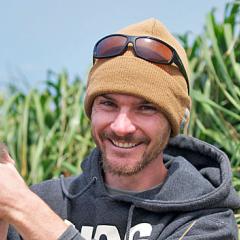Carle interviewed for radio story about Santa Cruz restoration project
With unspoiled ocean views and easy access to beaches, West Cliff Drive is prime real estate in Santa Cruz. Josh Adams, an ecologist with the United States Geological Survey in Santa Cruz, says those coastal cliffs are ideal spots for seabirds too.
A thriving colony of Brandt’s cormorants lives at Natural Bridges. Adams says this colony is unique because few native seabirds nest within cities along the California coast. “Most of the seabirds in our system nest on offshore rocks and islands that are predator free,” he says.
But the cormorant colony living in Santa Cruz had a problem: Ice plant covered the few ledges where the birds nest. Ice plant provides cover and food for introduced rats, which are predators on seabirds.
To help these seabirds, Adams worked with Bill Henry, an ecologist at Moss Landing Marine Laboratory, to get permission from the city to remove the ice plant from a terrace below the parking lot at Natural Bridges State Park.
“Within one day we saw the cormorants respond and start building nests in cleared areas,” Adams says. “It was dramatic. We knew it would work but not that dramatically.”
The two scientists then identified other sites along West Cliff Drive where ripping out ice plant might help the seabirds. And the non-profit West Cliff Ecosystem Restoration project was born. The project aims to bring native habitat back to the cliffs along West Cliff Drive.
Ecologist Bill Henry says thinking of the kids motivates him to do the restoration. “I have two daughters and we’re out here on West Cliff all the time,” he says. “[I] want them to be exposed to more biodiversity instead of seeing a monoculture landscape of introduced plants.
Last winter, volunteers with the project removed some ice plant from the cliff edge outside the state park. They replaced it with tiny seedlings of feathery yarrow, bushy lizardtail, and hearty gumweed. In early February, the scientists and more volunteers were back widening the bed and planting more seedlings.
Some of the plants from last year are the same size as the new seedlings. Even though the plants are adapted to handle the tough conditions on a cliff edge, the wind and the salt spray stunt their initial growth.
Adams says the native plants are tough and rugged, despite their small size. “But they need a little bit of help,” he says. “We’re going to try to get them established and then maybe we won’t have to shepherd them along.”
Adams expects the native plants will eventually crowd out the ice plant. Such restoration has been successful at Piedras Blancas and Wilder Ranch. He recommends driving up Highway 1 to three mile and four mile in the springtime to see the diversity of plants fronting the beach there.
“It’s really spectacular,” he says. “And then take a drive down West Cliff and see what impression you have of where you were and where you are now. I think where we want to be is a little bit similar to what’s going on in the north coast of Santa Cruz.”
A diversity of plants attracts a diversity of wildlife, says Ryan Carle, an ecologist with Oikonos Ecosystem Knowledge, a nonprofit conservation and research organization.
The wintering monarch butterflies at Natural Bridges like the flowers of the native plants. Local song birds might breed in the shrubs when they get bigger. And the plants also provide habitat for alligator lizards and salamanders, too.
“We’re sort of not just restoring several plant species, but we’re actually kind of changing the ecosystem back to what was functioning here before we disrupted it,” Adams says.
